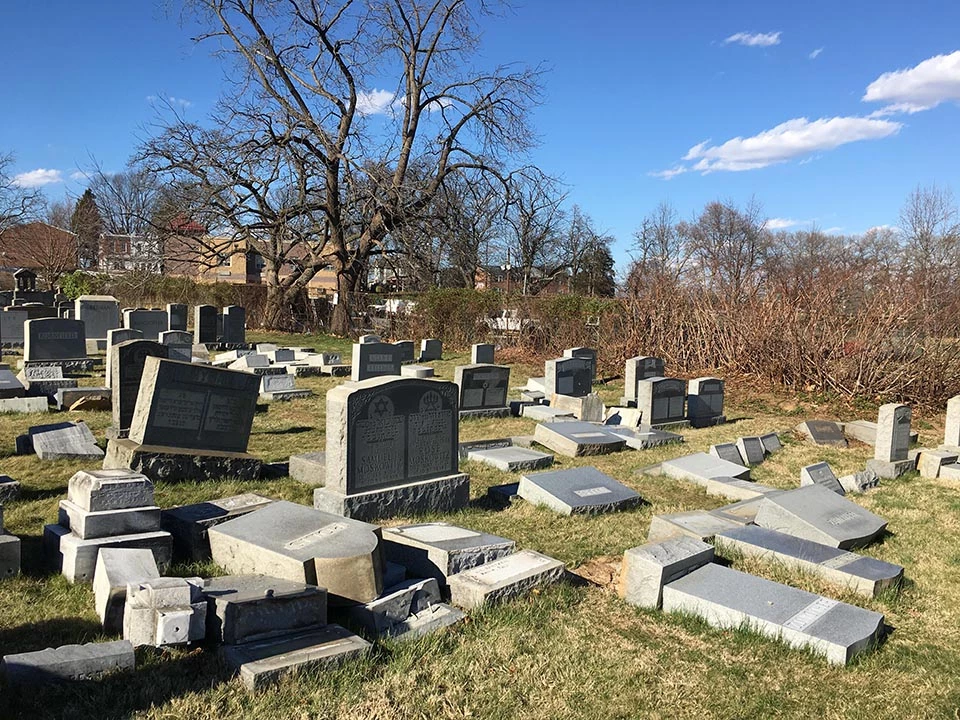Last updated: January 10, 2018
Article
From Desecration to Preservation: Mount Carmel Jewish Cemetery and the NPS Northeast Region
In February 2017, visitors to Philadelphia’s Mount Carmel Jewish Cemetery were shocked at the sight of hundreds of toppled granite and marble monuments. The act of vandalism looked like a tornado had cut through the site.
A descendant of people who are buried at the cemetery contacted Dennis Montagna, who leads the National Park Service Northeast Region’s Monument Research and Preservation Program and has worked extensively with cemetery preservation efforts. Montagna phoned the cemetery’s manager and offered to help plan a conservation response to the damage. Within a few months, a consortium of conservators, masons, volunteers and staff from the Jewish Federation of Greater Philadelphia had assessed the cemetery’s needs and then reset hundreds of monuments.
A descendant of people who are buried at the cemetery contacted Dennis Montagna, who leads the National Park Service Northeast Region’s Monument Research and Preservation Program and has worked extensively with cemetery preservation efforts. Montagna phoned the cemetery’s manager and offered to help plan a conservation response to the damage. Within a few months, a consortium of conservators, masons, volunteers and staff from the Jewish Federation of Greater Philadelphia had assessed the cemetery’s needs and then reset hundreds of monuments.


Left image
Damage from vandalism at the Mount Carmel Jewish Cemetery.
Credit: NPS photo
Right image
Army personnel work to repair damage in the Mount Carmel Jewish Cemetery.
Credit: NPS photo
Response planning began with a donated aerial survey of the cemetery coupled with an on the ground assessment. Montagna observed, “These two planning activities were really key. They pinpointed the path and magnitude of the February vandalism, but they also revealed that many monuments--hundreds of them, in fact--were already lying on the ground before the attack. They had fallen or been toppled years ago and had been ignored. The ground survey showed hundreds more leaning precariously. These formed a real danger to visitors and cemetery workers, so we decided that we would have to treat the cemetery as a whole, and not merely respond to the recent incident of vandalism.”
The NPS provided expertise in stabilizing and preserving monuments and vetted members of the preservation team. The Jewish Federation coordinated both labor and the donations that poured in from throughout the nation in the wake of the vandalism. Despite the temptation to act quickly after the violent incident, it was more important to plan carefully before moving anything. The Federation was able to hire a conservator, who supervised a team of masons that had never before worked with cemetery monuments. The masons brought with them a portable crane, one small enough to move down the narrow rows of monuments. Working within the large swath of vandalism, the team methodically lifted, leveled, and reset any monument found to be toppled or badly leaning. Six weeks and more than five hundred monuments later, the most badly damaged area of the cemetery had become an exemplar of what could be achieved through thoughtful preservation planning and treatment.
With the monuments reset and stable, attention turned to the security needs and to better landscape maintenance. Donated funds replaced damaged fencing and provided better lighting. Volunteers from the Pennsylvania National Guard brought in stabilizing topsoil, while students attending summer camps weeded and eliminating unwanted vegetation.
Looking back at the work accomplished and at what lies ahead, Montagna said, “We tried to respond to the immediate need, to address the vandalism and set things right, but we also embraced a larger mission, to provide a model of cemetery care that can be used elsewhere. The problems of Mount Carmel are shared by countless historic cemeteries that see very few burials and therefore very little income stream. These are important places for families whose ancestors are remembered here, but they are also places that can help us to better understand a larger history, in this case the history of a mostly first and second generation Jewish population that came from Eastern Europe and made Philadelphia their home.”
The NPS provided expertise in stabilizing and preserving monuments and vetted members of the preservation team. The Jewish Federation coordinated both labor and the donations that poured in from throughout the nation in the wake of the vandalism. Despite the temptation to act quickly after the violent incident, it was more important to plan carefully before moving anything. The Federation was able to hire a conservator, who supervised a team of masons that had never before worked with cemetery monuments. The masons brought with them a portable crane, one small enough to move down the narrow rows of monuments. Working within the large swath of vandalism, the team methodically lifted, leveled, and reset any monument found to be toppled or badly leaning. Six weeks and more than five hundred monuments later, the most badly damaged area of the cemetery had become an exemplar of what could be achieved through thoughtful preservation planning and treatment.
With the monuments reset and stable, attention turned to the security needs and to better landscape maintenance. Donated funds replaced damaged fencing and provided better lighting. Volunteers from the Pennsylvania National Guard brought in stabilizing topsoil, while students attending summer camps weeded and eliminating unwanted vegetation.
Looking back at the work accomplished and at what lies ahead, Montagna said, “We tried to respond to the immediate need, to address the vandalism and set things right, but we also embraced a larger mission, to provide a model of cemetery care that can be used elsewhere. The problems of Mount Carmel are shared by countless historic cemeteries that see very few burials and therefore very little income stream. These are important places for families whose ancestors are remembered here, but they are also places that can help us to better understand a larger history, in this case the history of a mostly first and second generation Jewish population that came from Eastern Europe and made Philadelphia their home.”
